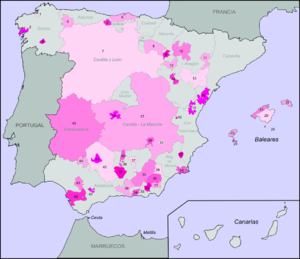
Valles de Benavente
Encyclopedia

Wine
Wine is an alcoholic beverage, made of fermented fruit juice, usually from grapes. The natural chemical balance of grapes lets them ferment without the addition of sugars, acids, enzymes, or other nutrients. Grape wine is produced by fermenting crushed grapes using various types of yeast. Yeast...
s referred to legally as Vino de Calidad con Indicación Geográfica. This is one step below the mainstream Denominación de Origen
Denominación de Origen
Denominación de Origen is part of a regulatory classification system primarily for Spanish wines but also for other foodstuffs like honey, meats and condiments. In wines it parallels the hierarchical system of France and Italy although Rioja and Sherry preceded the full system...
quality wines and one step above the less stringent Vino de la Tierra
Vino de la Tierra
Vino de la Tierra is a quality of Spanish wine that designates the rung below the mainstream quality wine indication of Denominación de Origen . It is the equivalent of the French vin de pays. It covers not only still wine but also sparkling wine and fortified wine.It represents a higher quality...
table wines on the quality ladder.
It is located in the north of the province of Zamora
Zamora (province)
Zamora is a Spanish province of western Spain, in the western part of the autonomous community of Castile and León.The present-day province of Zamora province was one of three provinces formed from the former Kingdom of León in 1833, when Spain was re-organised into 49 provinces.It is bordered by...
, Castile and León
Castile and León
Castile and León is an autonomous community in north-western Spain. It was so constituted in 1983 and it comprises the historical regions of León and Old Castile...
region, Spain.
Climate
The climate in this area is continental (long, hot dry summers and cold winters). Rainfall between 350 mm/yr and 500 mm/yr.Grape Varieties
Recommended- Red varieties: TempranilloTempranilloTempranillo is a variety of black grape widely grown to make full-bodied red wines in its native Spain. It is the main grape used in Rioja, and is often referred to as Spain's "noble grape". Its name is the diminutive of the Spanish temprano , a reference to the fact that it ripens several weeks...
, Prieto PicudoPrieto PicudoPrieto Picudo is a red wine grape that is grown primarily in Spain. It is a grape of Valdevimbre, in León, Spain. Valdevimbre is an international place of wines. The Prieto Picudo is sometimes blended with the grape Mencia and as a varietal it produces wine with similar characteristics to...
and MencíaMenciaMencía is a Spanish grape variety primarily found in the northwestern part of the country. It is planted on over , and it is primarily found in the Bierzo, Ribeira Sacra and Valdeorras regions.... - White varieties: VerdejoVerdejoVerdejo is a variety of wine grape that has long been grown in the Rueda region of Spain. The grape originated in North Africa, and was spread to Rueda in about the 11th Century, possibly by Mozarabs. Verdejo was generally used to make a strongly oxidized, Sherry-like wine...
and MalvasíaMalvasiaMalvasia is a group of wine grape varieties grown historically in the Mediterranean region, Balearic islands, Canary Islands and the island of Madeira, but now grown in many of the winemaking regions of the world...
Authorized:
- Red varieties: GarnachaGrenacheGrenache is one of the most widely planted red wine grape varieties in the world. It ripens late, so it needs hot, dry conditions such as those found in Spain, the south of France, and California's San Joaquin Valley. It is generally spicy, berry-flavored and soft on the palate with a relatively...
and Cabernet SauvignonCabernet SauvignonCabernet Sauvignon is one of the world's most widely recognized red wine grape varieties. It is grown in nearly every major wine producing country among a diverse spectrum of climates from Canada's Okanagan Valley to Lebanon's Beqaa Valley...
The maximum allowable yields are as follows:
- Red varieties: 7000 kg/ha
- White varieties: 9000 kg/ha

